Google Authenticator has introduced a new feature that allows users to sync their one-time two-factor authentication (2FA) codes to their Google accounts. Previously, these codes were stored locally on a single device, making it difficult to sign in to any services set up with Authenticator’s 2FA in case of losing the device. However, with the new update, users can back up their codes to Google’s cloud and restore them on any new device they use. This feature offers convenience without compromising security, according to Christiaan Brand, a group product manager at Google.
The update, announced in a blog post, aims to make one-time codes more durable by storing them safely in users’ Google accounts. To benefit from the sync feature, users simply need to update the Authenticator app and sign in to their Google account. They can also manually transfer their codes to another device, even if they’re not signed in to a Google account, following the steps on the support page.
While some users may have concerns about syncing their sensitive codes with Google’s cloud, Brand claims the feature is designed to enhance convenience without compromising security. However, Google’s Authenticator app has not always been transparent about its roadmap. Though the app started as an open-source project, it later became proprietary, and the official open-source forks of the Android, iOS, and BlackBerry apps have not been updated in years.
In conclusion, Authenticator’s new sync feature offers greater convenience and security to users, making one-time codes more durable and accessible. Nevertheless, several alternatives are available for 2FA, such as Authy and Duo, which are popular choices for users who prefer other options.


